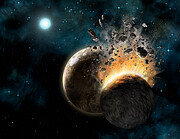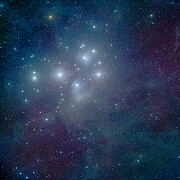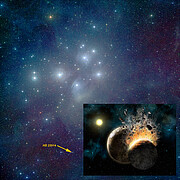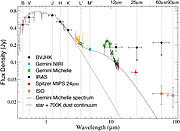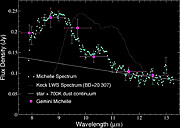Astronomers Spot Evidence for Colliding Planet Embryos in Famous Star Cluster
14 November 2007
Astronomers have found evidence for the formation of young rocky planets around the star HD 23514 located in the well-known Pleiades (Seven Sisters) star cluster that is easily visible in the current evening sky.
Using an infrared sensitive camera (MICHELLE) on the Gemini North Telescope, Joseph Rhee of UCLA and his collaborators have measured heat from hot dust surrounding a 100 million year old star in the bright star cluster. The star has properties very much like our Sun except that it is 45 times younger and is orbited by hundreds of thousands of times more dust than our Sun. The star is also one of the very few solar-type stars known to be orbited by warm dust particles.
These warm emissions betray catastrophic collisions in an evolving young planetary system around an adolescent-age solar type star. The emission appears to originate from dust located in the terrestrial planet zone between about 1/4 to two astronomical units (AUs) from the parent star HD 23514, a region corresponding to the orbits of Mercury and Mars in our solar system.
Rhee and team members Inseok Song of the Spitzer Science Center and Benjamin Zuckerman of UCLA interpret the presence of so much hot dust as a result of colliding planetary embryos leading to the conclusion that a recent collision occurred between relatively large rocky bodies. According to Zuckerman, this is thought to be similar to the encounter that produced the Earth-Moon system more than four billions ago. "Indeed, the collision that generated the Moon sent a comparable mass of debris into interplanetary orbits as is now observed in HD 23514," said Zuckerman.
The astronomers analyzing the emission from countless microscopic dust particles propose that the most likely explanation is they were pulverized in the violent collision of planets or “planetary embryos.” Song calls the dust particles the “building blocks of planets,” which accumulate into comets and small asteroid-size bodies, and then clump together to form planetary embryos, and finally full-fledged planets. “In the process of creating rocky, terrestrial planets, some objects collide and grow into planets, while others shatter into dust; we are seeing that dust,” Song said.
These new observations indicate that rocky terrestrial planets, perhaps like the Earth, Mars or Venus, appear to be forming or to have recently formed. “This is the first clear evidence for planet formation in the Pleiades, and the results we are presenting strongly suggest that terrestrial planets like those in our solar system are quite common,” said Joseph Rhee, UCLA postdoctoral scholar in astronomy, and lead author of the research.
Astronomers report the findings in an upcoming issue of the Astrophysical Journal, published by the American Astronomical Society.
The Pleiades star cluster, in the constellation of Taurus, is easily visible to the naked eye at this time of the year. The cluster is well-known in many cultures, and is cited in the Bible, noted Rhee: “Can you bind the beautiful Pleiades? Can you loose the cords of Orion?” ( Job 38:31).
Although referred to as the seven sisters, “the cluster actually contains some 1,400 stars,” said Inseok Song, a staff scientist at Caltech’s Spitzer Science Center, former astronomer with the Gemini Observatory, and a co-author of the research. Located about 400 light years away, the Pleiades is one of the closest star clusters to Earth.
Background
- The research team used the Gemini North telescope on Mauna Kea on the island of Hawaii to measure the heat radiation coming from the dust; “this heat emerges at infrared wavelengths, just as the heat from our bodies does,” Song said. “The Gemini data were crucial” in establishing the amount and location of dust around the star, he said.
- The Pleiades star (HD 23514) is the second star around which Song and Zuckerman have recently found evidence of terrestrial planet formation. They and colleagues reported in the journal Nature in July 2005 that a sun-like star, known as BD+20 307, located 300 light-years from Earth in the direction of the constellation Aries, is surrounded by a shocking one million times more dust than is orbiting around our sun. According to Zuckerman HD 23514, “…has hundreds of thousands of time as much dust as around our sun.”
- While the sun is 4.5 billion years old, both HD 23514 and BD+20-307 are “adolescents,” about 100 million and 400 million years old, respectively, Rhee said. Based on the age of the two stars and the dynamics of the orbiting dust particles, the astronomers deduce that most adolescent-age sun-like stars are likely to be building terrestrial-like planets via recurring violent collisions of massive objects, but the cosmic debris from only a small percentage can be seen at any one time — currently, only stars HD23514 and BD+20 307 are known.
- HD23514 and BD+20 307 are by far the dustiest not-so-young stars in the sky, Song said; “nothing else is even close.” Very young stars, 10 million years old or younger, may have this much dust around them, as a remnant of the star formation process. However, by the time a star is 100 million years old, the dust has dissipated because the dust particles get blown away or dragged onto the star, or the particles clump together to form much larger objects.
- In parts of Polynesia and Hawai‘i, the Pleiades were used to help determine the start of the new year (the New Year celebration is called Makahiki in Hawaii). In Hawai‘i the cluster is known as Makali‘i.
- “In Greek mythology, the Pleiades represented Seven Sisters; to the Vikings, the Pleiades was Freyja's hens,” Rhee said. In Bronze Age Europe, the Celts and others associated the Pleiades with mourning and funerals because the cluster rose in the eastern night sky between the autumn equinox and the winter solstice, which was a festival devoted to the remembrance of the dead. The ancient Aztecs of Mexico and Central America based their calendar upon the Pleiades.
- The results are based on mid- and far- infrared observations made with the Gemini 8-meter Frederick C. Gillett Telescope (Gemini North) and space-based infrared observatories: Infrared Astronomical Satellite (IRAS), Infrared Space Observatory (ISO), and Spitzer Space Telescope.
- The Gemini Observatory is an international collaboration with two identical 8-meter telescopes. The Frederick C. Gillett Gemini Telescope is located at Mauna Kea, Hawai'i (Gemini North) and the other telescope at Cerro Pachón in central Chile (Gemini South), and hence provide full coverage of both hemispheres of the sky. Both telescopes incorporate new technologies that allow large, relatively thin mirrors under active control to collect and focus both optical and infrared radiation from space.
- UCLA is California’s largest university, with an enrollment of nearly 37,000 undergraduate and graduate students. The UCLA College of Letters and Science and the university’s 11 professional schools feature renowned faculty and offer more than 300 degree programs and majors. UCLA is a national and international leader in the breadth and quality of its academic, research, health care, cultural, continuing education and athletic programs. Four alumni and five faculty have been awarded the Nobel Prize.
Contacts
Peter Michaud
Gemini Observatory
Hilo, HI 96720
Tel: 1 (808) 974-2510
Cell: 1(808) 936-6643
Email: pmichaud@gemini.edu
Stuart Wolpert
UCLA
Tel: (310) 206-0511
Email: swolpert@support.ucla.edu
About the Release
| Release No.: | gemini0707 |
| Name: | HD 23514 |
| Facility: | Gemini North |
| Instruments: | Michelle |
| Science data: | 2008ApJ...675..777R |


